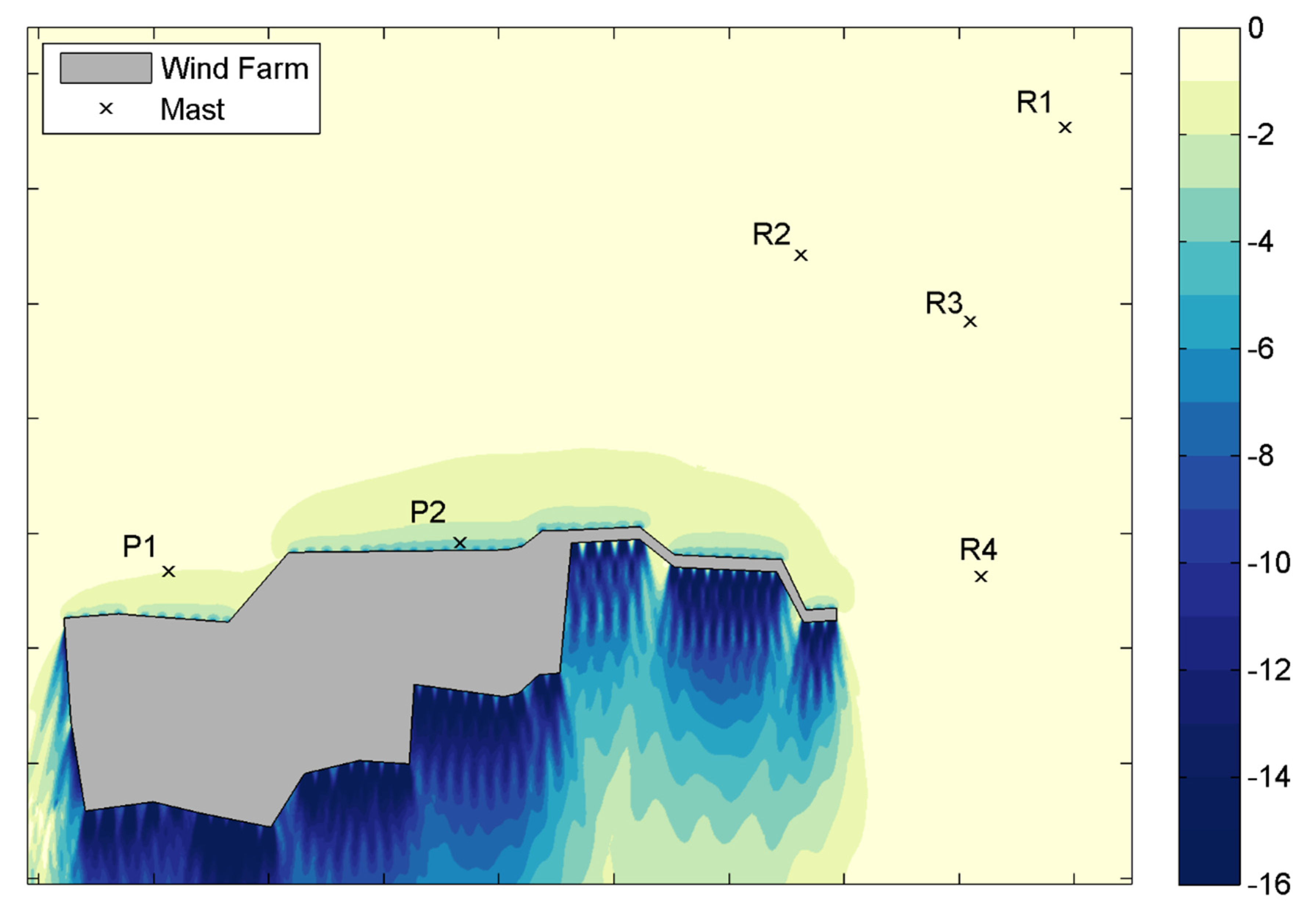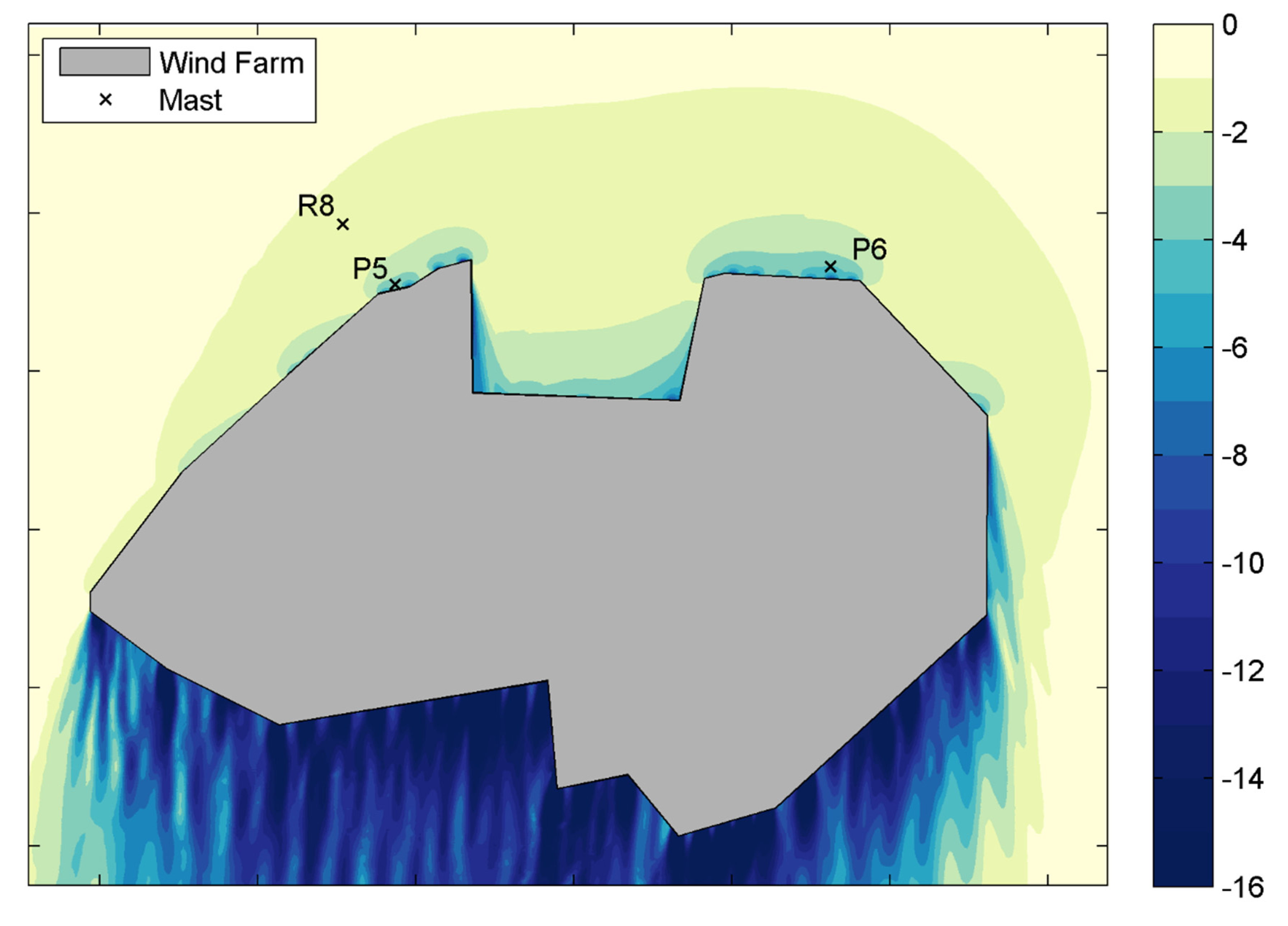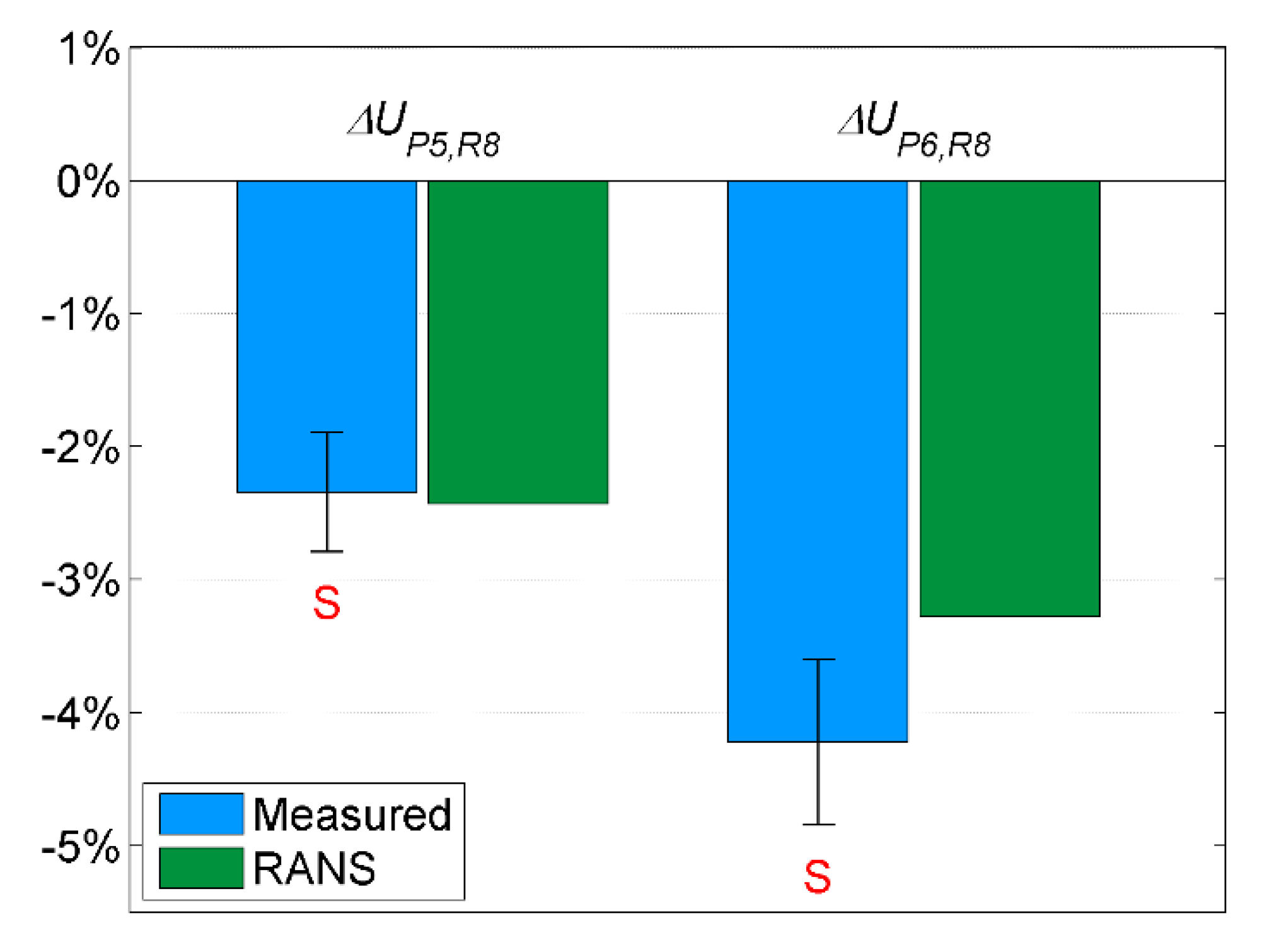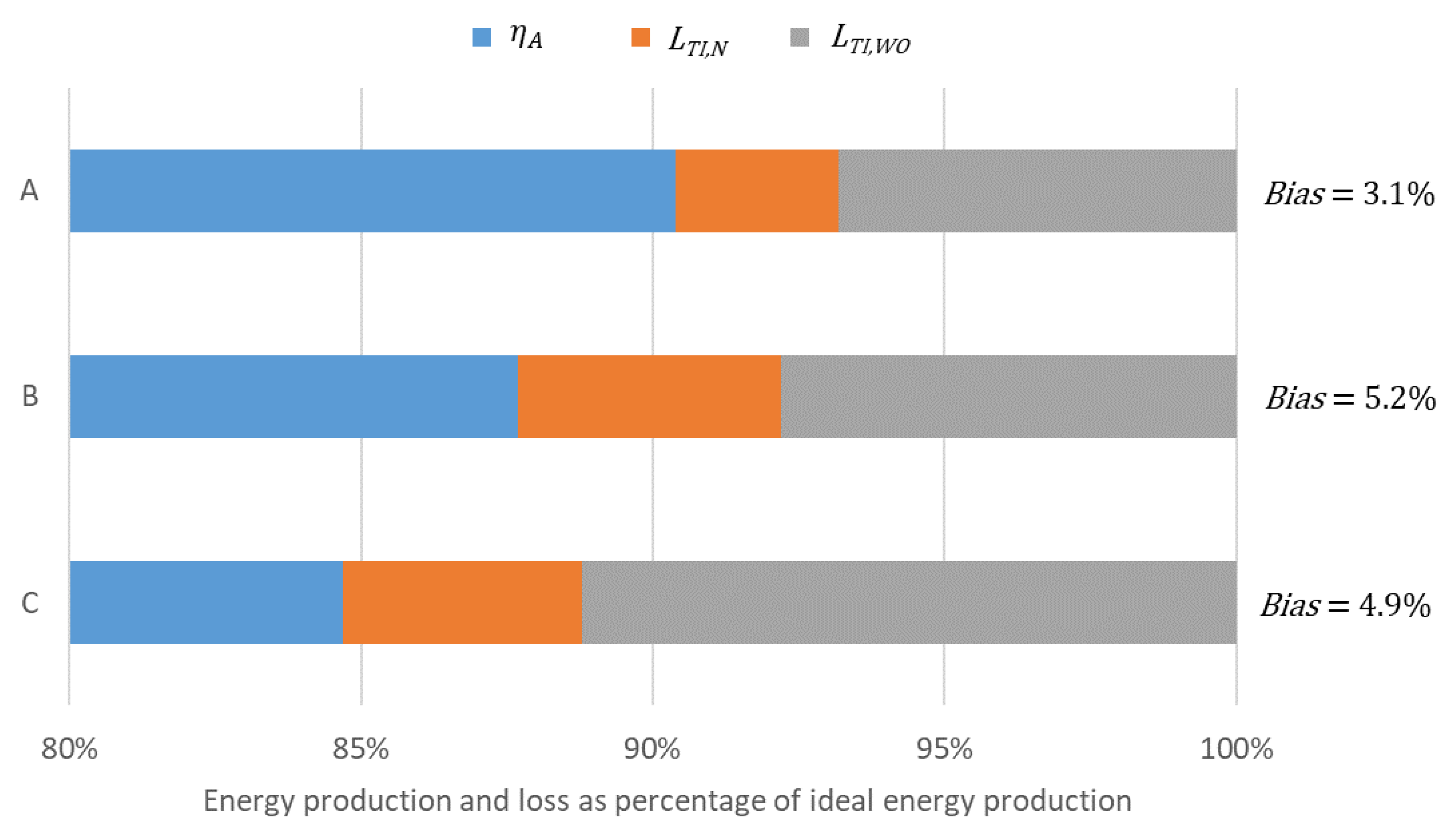Wind Farm Blockage and the Consequences of Neglecting Its Impact on Energy Production
Abstract
:1. Introduction
2. Measurements
- At least one meteorological mast located just upstream of the wind farm for the prevailing wind direction (e.g., Mast P in Figure 2).
- At least one additional mast located much farther upstream or lateral to the wind farm for the prevailing wind direction (e.g., Mast R in Figure 2).
- The masts have been taking wind speed and direction measurements concurrently before and after the wind farm commercial operation date (COD).
- Filter for wind direction—Define a 30° wind direction sector where the two masts are not waked. Select records where the mean wind direction at the perimeter mast is within the chosen sector. Remove records for which the perimeter mast record immediately before or after has a mean wind direction outside the sector of interest—this reduces the risk of a turbine wake affecting a mast during any part of a selected 10 min record.
- Filter for wind speed—Select records where the mean wind speed at the perimeter mast is between 5 m/s and 9 m/s, where most of the turbines are expected to operate on the plateau of the turbine’s thrust coefficient (Ct) curve.
- Filter for turbine availability—Select records where at least 90% of the wind farm turbines are available. In addition, remove records where the turbines closest to the perimeter mast are offline. This filter does not apply to the before-COD time series.
- Filter for concurrency—Select records where both the perimeter mast and the reference mast have a valid wind speed value.
3. Modeling
4. Results
4.1. Wind Farm A
4.2. Wind Farm B
4.3. Wind Farm C
5. Implications
- Wind speeds at upstream perimeter masts are lower than freestream
- Lower mast wind speeds mean the individual turbines just downstream produce less energy than current EPA practices would estimate
- The group of turbines on the upstream perimeter of a wind farm also produce less than EPA practices would estimate
- Prediction bias on the upstream perimeter pervades the wind farm
- The magnitude of the overprediction bias in the wakes-only approach to turbine interaction can be significant
- Power curves are probably an additional source of bias
5.1. Perimeter Mast Wind Speeds Are Lower than Freestream
5.2. Lower Mast Wind Speeds Mean Nearby Turbines Will Underproduce Compared to Expectations
5.3. The Group of Turbines on the Upstream Perimeter Will Underproduce Compared to Expectations
5.4. Prediction Bias on the Upstream Perimeter Pervades the Wind Farm
5.5. The Wakes-Only Prediction Bias Can Be Large
- For each unwaked turbine, replace the RANS-predicted turbine power from the wind farm simulation () with the turbine power corresponding to its simulation in isolation ().
- Calculate a scaling factor equal to the factor by which Step 1 increases the total predicted power of the unwaked, waking turbines. Unwaked, non-waking turbines, such as those on the eastern end of Wind Farm A (Figure 5), are not included in the calculation of this factor.
- For each waked turbine, apply the scaling factor to the RANS-predicted power, , in order to preserve the original power relationship between the waked turbines and the unwaked turbines waking them.
5.6. Bias in Power Curves
6. Conclusions
Author Contributions
Funding
Acknowledgments
Conflicts of Interest
References
- Sanderse, B. Aerodynamics of Wind Turbine Wakes—Literature Review; Report ECN-E-09-016; Energy Research Center of the Netherlands: Petten, The Netherlands, 2009. [Google Scholar]
- Walker, K.; Adams, N.; Gribben, B.; Gellatly, B.; Nygaard, N.G.; Henderson, A.; Jiménez, M.M.; Schmidt, S.R.; Ruiz, J.R.; Paredes, D.; et al. An evaluation of the predictive accuracy of wake effects models for offshore wind farms. Wind Energy 2015. [Google Scholar] [CrossRef]
- Frandsen, S.; Barthelmie, R.; Pryor, S.; Rathmann, O.; Larsen, S.; Højstrup, J. Analytical modelling of wind speed deficit in large offshore wind farms. Wind Energy 2006, 9, 39–53. [Google Scholar] [CrossRef]
- DNV GL. WindFarmer Theory Manual; Version 5.3; DNV GL: Bristol, UK, 2014; pp. 14–20. [Google Scholar]
- Brower, M.C.; Robinson, N.M. The OpenWind Deep-Array Wake Model; AWS Truepower: Albany, NY, USA, 2012. [Google Scholar]
- Rodrigo, J.S.; Moriarty, P.; Nouqueret, E.C.; Arroyo, R.A.C.; Churchfield, M.; Hansen, K.S. WAKEBENCH Best Practice Guidelines for Wind Farm Flow Models, 1st ed.; IEA-Wind Task 31; International Energy Agency: Paris, France, 2015. [Google Scholar]
- Clifton, A.; Smith, A.; Fields, M. Wind Plant Preconstruction Energy Estimates: Current Practice and Opportunities; Report NREL/TP-5000-64735; National Renewal Energy Laboratory: Golden, CO, USA, 2016. [Google Scholar]
- Manwell, J.F.; McGowan, J.G.; Rogers, A.L. Wind Energy Explained: Theory, Design and Application, 2nd ed.; Wiley: Hoboken, NJ, USA, 2010; pp. 423–427. [Google Scholar]
- Barthelmie, R.J.; Jensen, L.E. Evaluation of wind farm efficiency and wind turbine wakes at the Nysted offshore wind farm. Wind Energy 2010, 13, 573–586. [Google Scholar] [CrossRef]
- Farris, S.; Henderson, A.; Whiting, R.; Fields, J.; Sherwin, B. IEC 61400-15 Assessment of Wind Resource, Energy Yield and Site Suitability Input Conditions for Wind Power Plants; Offshore Wind Energy: London, UK, 2017. [Google Scholar]
- Barthelmie, R.J.; Hansen, K.; Fransen, S.; Rathmann, O.; Schepers, J.G.; Schlez, W.; Phillips, J.; Rados, K.; Zervos, A.; Politis, E.S.; et al. Modelling and measuring flow and wind turbine wakes in large wind farms offshore. Wind Energy 2009, 12, 431–444. [Google Scholar] [CrossRef]
- Ebenhoch, R.; Muro, B.; Dahlberg, J.A.; Hägglund, P.B.; Segalini, A. A linearized numerical model of wind-farm flows. Wind Energy 2016. [Google Scholar] [CrossRef]
- Allaerts, D.; Meyers, J. Gravity waves and wind-farm efficiency in neutral and stable conditions. Bound.-Layer Meteorol. 2017, 166, 269–299. [Google Scholar] [CrossRef]
- Wu, K.L.; Porté-Agel, F. Flow adjustment inside and around large finite-size wind farms. Energies 2017, 10. [Google Scholar] [CrossRef]
- Nishino, T.; Draper, S. Local blockage effect for wind turbines. J. Phys. Conf. Ser. 2015, 625. [Google Scholar] [CrossRef]
- Nishino, T.; Willden, R.H.J. The efficiency of an array of tidal turbines partially blocking a wide channel. J. Fluid Mech. 2012, 708, 596–606. [Google Scholar] [CrossRef]
- McTavish, S.; Rodrigue, S.; Feszty, D.; Nitzsche, F. An investigation of in-field blockage effects in closely spaced lateral wind farm configurations. Wind Energy 2015, 18, 1989–2011. [Google Scholar] [CrossRef]
- Forsting, A.R.M.; Troldborg, N.; Gaunaa, M. The flow upstream of a row of aligned wind turbine rotors and its effect on power production. Wind Energy 2017, 20, 63–77. [Google Scholar] [CrossRef]
- Mitraszewski, K.; Hansen, K.S.; Nygaard, N.G.; Rethoré, P.E. Wall Effects in Offshore Wind Farms. In Proceedings of the Torque Conference, Oldenburg, Germany, 9–11 October 2012. [Google Scholar]
- Seshadhri, S.; Montavon, C.; Jones, I. Coriolis Effects in the Simulation of Large Array Losses: Preliminary Results on ‘Wall Effect’ and Wake Asymmetry. In Proceedings of the EWEA Offshore, Copenhagen, Denmark, 4–7 February 2013. [Google Scholar]
- Jog, C.; (EDF Energy Renewables, Portland, OR, USA); Nygaard, N.G.; (Ørsted, Copenhagen, Denmark). Personal communications, 2017.
- Mann, H.B.; Whitney, D.R. On a test of whether one or two random variables is stochastically larger than the other. Ann. Math. Stat. 1947, 18, 50–60. [Google Scholar] [CrossRef]
- Siemens PLM Software. User Guide for STAR-CCM+; Version 12; Siemens PLM Software: Plano, TX, USA, 2017. [Google Scholar]
- Bleeg, J.; Digraskar, D.; Woodcock, J.; Corbett, J.F. Modeling stable thermal stratification and its impact on wind flow over topography. Wind Energy 2014. [Google Scholar] [CrossRef]
- Bleeg, J.; Digraskar, D.; Horn, U.; Corbett, J.F. Modelling Stability at Microscale, Both Within and Above the Atmospheric Boundary Layer, Substantially Improves Wind Speed Predictions. In Proceedings of the EWEA Conference, Paris, France, 17–20 November 2015. [Google Scholar]
- Thunis, P.; Bornstein, R. Hierarchy of Mesoscale Flow Assumptions and Equations. J. Atmos. Sci. 1995, 53, 380–397. [Google Scholar] [CrossRef]
- Van der Laan, M.; Sørensen, N.N.; Réthoré, P.E.; Mann, J.; Kelly, M.C. The k-ε-fp model applied to double wind turbine wakes using different actuator disk force methods. Wind Energy 2014. [Google Scholar] [CrossRef] [Green Version]
- Gaumond, M.; Réthoré, P.E.; Ott, S.; Peña, A.; Bechmann, A.; Hansen, K.S. Evaluation of the wind direction uncertainty and its impact on wake modeling at the Horns Rev offshore wind farm. Wind Energy 2014, 17, 1169–1178. [Google Scholar] [CrossRef] [Green Version]
- Troldborg, N.; Zahle, F.; Réthoré, P.E.; Sørensen, N.N. Comparison of wind turbine wake properties in non-sheared inflow predicted by different computational fluid dynamics rotor models. Wind Energy 2015, 18, 1239–1250. [Google Scholar] [CrossRef]
- International Electrotechnical Commission. IEC 61400-12-1:2017, Wind Energy Generation Systems–Part. 12-1: Power Performance Measurements of Electricity Producing Wind Turbines; International Electrotechnical Commission: Geneva, Switzerland, 2017. [Google Scholar]
- Brower, M. Wind Turbine Performance: Issues and Evidence. Presented at the EWEA Conference, Lyon, France, 2–3 July 2012. [Google Scholar]
- Harman, K. How Does the Real World Performance of Wind Turbines Compare with Sales Power Curves. Presented at the EWEA Conference, Lyon, France, 2–3 July 2012. [Google Scholar]
- Young, M. Power Curve Measurement Experiences and New Approaches. Presented at the EWEA Resource Assessment Workshop, Dublin, Ireland, 21 November 2013. [Google Scholar]
- Ostridge, O. Understand & Predicting Turbine Performance. Presented at the AWEA Wind Resource & Project Energy Assessment Seminar, Orlando, FL, USA, 2–3 December 2014. [Google Scholar]
- Bernadett, D. Power Curve Loss Adjustments at AWS Truepower. Presented at the 20th meeting of the Power Curve Working Group, Minneapolis, MN, USA, 29 September 2016. [Google Scholar]
- Nygaard, N.G.; Hansen, S.D. Wake effects between two neighbouring wind farms. J. Phys Conf. Ser. 2016, 625. [Google Scholar] [CrossRef]
- Hägglund, P.B. An Experimental Study on Global Turbine Array Effects in Large Wind Turbine Clusters. Master’s Thesis, KTH Royal Institute of Technology, Stockholm, Sweden, 2013. [Google Scholar]
- Geer, T. Improving Confidence in Wake Predictions through Operational Validations. Presented at Wind Europe Offshore, London, UK, 6–8 June 2017. [Google Scholar]
- Nygaard, N.G.; Brink, F.E. Measurements of the Wind Turbine Induction Zone. Presented at the Wind Energy Science Conference, Lyngby, Denmark, 26–29 June 2017. [Google Scholar]











© 2018 by the authors. Licensee MDPI, Basel, Switzerland. This article is an open access article distributed under the terms and conditions of the Creative Commons Attribution (CC BY) license (http://creativecommons.org/licenses/by/4.0/).
Share and Cite
Bleeg, J.; Purcell, M.; Ruisi, R.; Traiger, E. Wind Farm Blockage and the Consequences of Neglecting Its Impact on Energy Production. Energies 2018, 11, 1609. https://doi.org/10.3390/en11061609
Bleeg J, Purcell M, Ruisi R, Traiger E. Wind Farm Blockage and the Consequences of Neglecting Its Impact on Energy Production. Energies. 2018; 11(6):1609. https://doi.org/10.3390/en11061609
Chicago/Turabian StyleBleeg, James, Mark Purcell, Renzo Ruisi, and Elizabeth Traiger. 2018. "Wind Farm Blockage and the Consequences of Neglecting Its Impact on Energy Production" Energies 11, no. 6: 1609. https://doi.org/10.3390/en11061609





